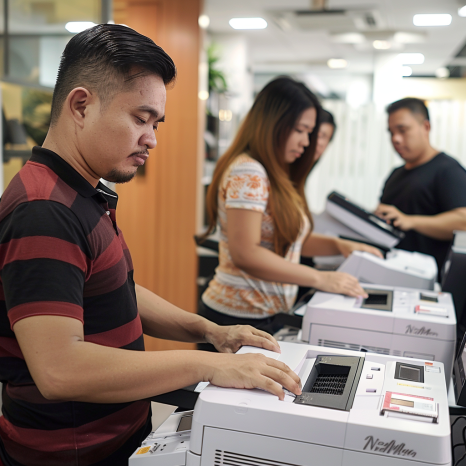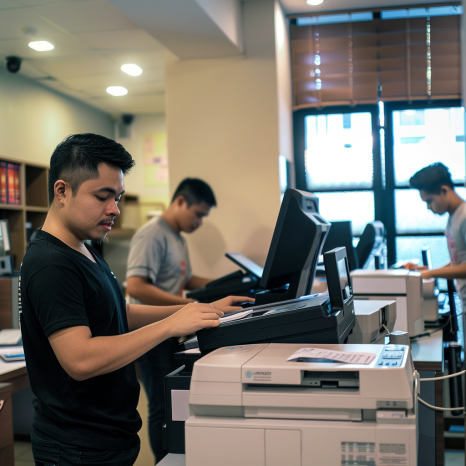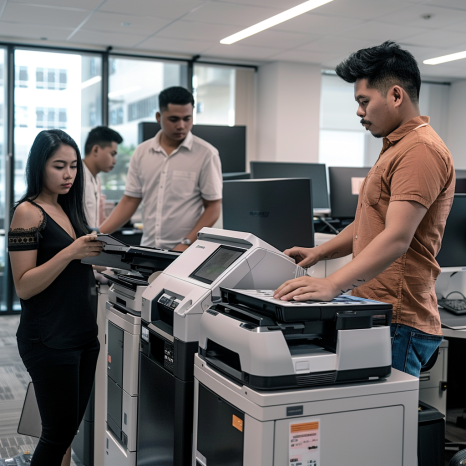
Cost Comparison: Short-term vs. Long-term
Part 1: Understanding the Basics and Key Factors of Printer Rentals
Cost Comparison: Short-term vs. Long-term: When deciding between short-term and long-term rentals for printers, it’s crucial to consider not just the immediate costs but also the broader impact on your business’s operational efficiency and budgeting strategies. In this first part of our series on printer rental, we’ll delve into the basic concepts, the benefits, and the factors affecting printer rentals.
To get started with understanding printer rentals, visit our comprehensive introduction to printer rentals for beginners!
Businesses aiming to boost their productivity should consider the advantages of using the best printers for office use. These printers are designed to enhance operational efficiency and improve overall workflow. To plan your expenses effectively, explore our insights on the cost of printer rentals.
For a thorough comparison between leasing and buying printers, you can delve into our detailed analysis of printer rentals vs. purchasing. This guide will help you decide which option aligns best with your business requirements. Additionally, to see the diverse range of printers available, check out our guide on the types of printers for rent, tailored to meet various business needs and printing demands.
For comprehensive details on the flexibility and terms provided by our printer rental contracts, visit our site. This information will assist you in selecting the optimal rental agreement for your business needs. Understand the benefits of short-term vs. long-term rentals to choose the best option for your business needs.
The Concept of Printer Rentals
Renting a printer, much like leasing a car, involves using a company’s printer for a predetermined period under a printer rental contract. This can be highly beneficial for various reasons, including cost savings, maintenance support, and access to the latest technology. Renting can be a flexible solution that adapts to your company’s changing needs, which is why understanding how printer rentals work is vital for making informed decisions.
Short-term vs. Long-term Rentals
Short-term rentals are typically chosen for specific, temporary needs such as events, projects, or peak business periods. This flexibility allows businesses to scale their resources according to their immediate needs without a significant long-term investment.
Long-term rentals, on the other hand, are suitable for businesses that need a stable, ongoing solution. They often come with more competitive rates and comprehensive maintenance plans, reducing the hassle of servicing and upgrading equipment.
Economic Considerations
One of the main reasons to opt for printer rentals is economic flexibility. Budgeting for printer rentals is simpler as it converts large capital expenditures into manageable operating expenses. This can be particularly advantageous for startups and small businesses where cash flow management is crucial.
The cost of renting a printer can vary widely based on several factors affecting printer rentals, including the type of printer, the duration of the rental, and additional services such as maintenance and supply replenishment.
Benefits of Printer Rentals
Opting for a printer rental can offer a multitude of benefits, as outlined on the benefits of printer rentals page. Some of these include:
- Convenience: Rentals eliminate the need for upfront investment and the hassle of maintenance. Companies can upgrade their equipment without renegotiating lease terms, providing a hassle-free solution to stay current with technology.
- Cost-effectiveness: Especially with cost-saving tips for printer rentals, businesses can significantly reduce expenses compared to purchasing.
- Flexibility and scalability: Adjust your printer fleet based on current business needs without committing to a long-term investment.
Legal and Policy Considerations
Understanding the legal considerations of printer rentals is also essential. This includes the terms of lease agreements, warranties, and policies regarding the use and maintenance of the equipment. Companies must ensure that rental agreements align with their business operations and legal standards to avoid potential disputes.
FAQs
What are the main benefits of renting a printer instead of buying?
- Renting a printer offers several advantages over purchasing:
- Financial Flexibility: Avoid the upfront capital expenditure of purchasing a printer outright. Renting allows for easier budget management and cash flow.
- Maintenance and Upgrades: Rental agreements typically include maintenance services, reducing the hassle of repairs and upkeep. Additionally, renting allows businesses to upgrade to newer models as technology advances without additional investment.
- Tax Efficiency: Rental payments are often deductible as business expenses, potentially reducing the net cost.
- Renting a printer offers several advantages over purchasing:
How do I decide between a short-term and a long-term rental?
- The decision between short-term and long-term rentals should consider the following factors:
- Duration of Need: If the printer is needed for a specific project or a short period, a short-term rental is more appropriate. For ongoing business needs, a long-term rental might be more cost-effective.
- Cost Implications: Long-term rentals can offer lower monthly rates compared to short-term agreements.
- Operational Flexibility: Short-term rentals offer more flexibility to adapt to changing business needs without a long-term commitment.
- The decision between short-term and long-term rentals should consider the following factors:
What should I look for in a printer rental contract?
- A comprehensive printer rental contract should address several key aspects:
- Lease Duration: Clearly defined rental periods with options for renewal.
- Service and Maintenance: Details on what maintenance is included and how often it is provided.
- Terms of Use: Guidelines on how the printer should be used to avoid any damage that could lead to additional charges.
- Upgrade and Termination Options: Conditions under which the printer can be upgraded or the rental agreement can be terminated early.
- A comprehensive printer rental contract should address several key aspects:
Are there different types of printers available for rent?
- Yes, there are various types of printers available for rent to meet different business needs, including inkjet printers, laser printers, and multifunction printers. Each type has its benefits, such as higher speed, better quality prints, or additional functionalities like scanning and faxing.
Can renting a printer help my business be more environmentally friendly?
- Renting can contribute to sustainability in several ways:
- Up-to-Date Technology: Regular updates to more efficient models can reduce waste and energy consumption.
- Reduced Waste: Leasing companies often refurbish and reuse equipment, which can help lower the environmental impact compared to buying and disposing of old equipment.
- Resource Sharing: By renting, companies share resources, potentially reducing the total number of printers required.
- Renting can contribute to sustainability in several ways:
What happens if the rented printer breaks down?
- Typically, the rental agreement will cover maintenance and repair services. The rental company is responsible for ensuring the equipment operates correctly, including handling repairs or replacements if the printer breaks down during the rental period.
How does printer rental impact my company’s scalability?
- Printer rentals provide scalability benefits by allowing businesses to adjust their printer fleet based on current needs without committing to long-term investments. This means a company can easily increase or decrease the number of printers as their business scales up or down.

Part 2: Cost Analysis of Short-Term vs. Long-Term Printer Rentals
Continuing our discussion on printer rentals, this section will delve deeper into the cost comparison between short-term and long-term options. We’ll also examine how strategic planning regarding printer rental contracts can affect overall business expenses.
Breaking Down Costs
The cost-effectiveness of printer rentals often depends on how well the terms of the rental align with your business needs. Factors such as rental duration, the volume of printing, and the type of printer all play significant roles in determining the total cost.
Short-Term Rentals: These are generally priced higher per day or month due to the flexibility they offer. Short-term rentals might include additional fees for quick setup and faster delivery schedules, which can be ideal for events or sudden increases in workload.
Long-Term Rentals: Opting for a long-term arrangement usually results in a lower monthly or annual cost. This option often includes benefits such as more comprehensive maintenance plans and the possibility of negotiating more favorable terms based on the extended commitment.
Analyzing Total Cost of Ownership (TCO)
When considering printer rentals, it’s essential to calculate the Total Cost of Ownership, which includes not just the rental fees but also other costs like:
- Maintenance Costs: Long-term contracts often spread these costs over time, potentially making them more manageable.
- Supply Costs: Depending on the contract, some rentals might include supplies like ink and toner, while others might not.
- Operational Costs: Energy consumption and the space used by the printer can also contribute to the total cost.
Comparing these costs for short-term and long-term rentals will provide a clearer picture of which option might be more cost-effective in different scenarios.
Strategic Benefits
Beyond mere cost, strategic benefits also play a crucial role:
- Flexibility and scalability: Short-term rentals offer the ability to adapt quickly to changing business needs without a long-term financial commitment.
- Sustainability in printer rentals: Longer contracts can encourage providers to offer more eco-friendly printers, aligning with corporate sustainability goals.
Cost Management and Optimization
To optimize the costs associated with printer rentals, consider the following tips:
- Cost-saving tips for printer rentals: Regular reviews of usage and needs can help adjust the rental agreement to avoid paying for unutilized resources.
- Negotiation of Terms: Leverage long-term commitments to negotiate lower overall costs and include clauses that favor your business needs, such as flexible upgrade options.
FAQs
How can I reduce costs with a printer rental agreement?
- To minimize costs when entering a printer rental agreement, consider the following strategies:
- Accurate Needs Assessment: Ensure that the printer model and the rental period closely match your actual business needs to avoid overpaying for unutilized capabilities or time.
- Inclusive Contracts: Look for contracts that include as many supplementary services as possible, such as maintenance, repairs, and even supplies, which can otherwise significantly increase costs.
- Bulk Deals: If renting multiple units, negotiate bulk deals or discounts that can lower the overall cost.
- To minimize costs when entering a printer rental agreement, consider the following strategies:
What are the hidden costs in printer rentals?
- Beyond the basic rental fee, several hidden costs can affect the total expense of renting a printer:
- Exceeding Quota Fees: If your contract has a printing limit, exceeding this quota can incur significant additional costs.
- Setup and Delivery Charges: Initial setup and delivery might be charged separately, especially in short-term rentals.
- Technology Upgrade Fees: Some contracts may include fees for technology upgrades or swapping models during the rental period.
- Beyond the basic rental fee, several hidden costs can affect the total expense of renting a printer:
Is it cheaper to rent a printer for a long-term project or buy it?
- While buying a printer may seem like a one-time cost, renting can offer financial advantages for long-term projects:
- Depreciation: Printers lose value over time, and owning outdated equipment can be a liability.
- Flexibility: Rentals allow for easy upgrades to newer technology, ensuring that your business is always equipped with the latest features.
- Predictable Budgeting: Rental agreements often turn large capital expenditures into predictable monthly expenses, aiding in smoother budget management.
- While buying a printer may seem like a one-time cost, renting can offer financial advantages for long-term projects:
How do short-term and long-term rentals impact budget planning?
- Short-term rentals: These are typically utilized for projects with a definitive end date, allowing businesses to plan expenses for a specific duration without long-term commitments.
- Long-term rentals: These help in long-term budget forecasting by locking in rates, which stabilizes printing costs over a more extended period.
Can negotiating the terms of a printer rental save money?
- Yes, negotiating the terms of your rental can lead to significant savings. Points of negotiation might include lower monthly rates, waivers for certain fees like setup or delivery, and inclusion of comprehensive maintenance plans without additional charges.
What should be included in a cost-effective printer rental agreement?
- A cost-effective rental agreement should ideally include:
- Competitive Pricing: Based on the market and the specific printer model.
- Maintenance and Service: To avoid unexpected repair costs.
- Flexible Terms: Allowing for adjustments based on usage patterns, such as scaling the number of printers up or down without penalty.
- A cost-effective rental agreement should ideally include:

Part 3: Legal Considerations and Final Thoughts on Printer Rentals
In this final section of our discussion on printer rentals, we delve into the legal considerations, and wrap up with a summary of the advantages and strategic implications of choosing between short-term and long-term printer rental options. We’ll also provide a call to action for those interested in exploring printer rental solutions with Marga Enterprises.
Legal Considerations in Printer Rentals
Understanding the legal considerations and legal factors involved in printer rentals is crucial to ensuring that both parties—the renter and the rental company—are protected under the terms of the agreement.
Contract Terms: Every printer rental agreement should clearly state the rental period, payment terms, what happens in case of equipment failure, responsibilities for maintenance, and conditions under which the contract can be terminated early.
Liability and Insurance: It’s essential to understand who is liable for damages or loss of the equipment during the rental period. Some rental agreements might require the renter to carry insurance on the equipment.
Compliance with Regulations: Ensure that the use of rented printers complies with industry-specific regulations, especially concerning data security and privacy if the printers are used to handle sensitive or personal information.
Summarizing the Strategic Benefits
Choosing the right printer rental can significantly impact your business operations. Here’s a quick recap of the strategic benefits discussed:
Cost Management: Effective budgeting and cost management through budgeting for printer rentals help businesses stabilize their financial outflows.
Operational Flexibility: With options like flexibility and scalability in printer rentals, companies can adapt their printing capabilities as their business needs change.
Technological Edge: Staying updated with the latest printing technology without significant capital investment through eco-friendly printers and sustainable printer options.
FAQs
What legal issues should I be aware of when entering a printer rental agreement?
- When entering into a printer rental agreement, it is crucial to consider several legal aspects:
- Contract Terms Clarity: Ensure all terms are explicitly stated, including payment schedules, termination rights, and responsibilities for damages.
- Dispute Resolution: Understand the procedures for resolving disputes, whether through mediation, arbitration, or legal proceedings.
- Compliance with Laws: Verify that the rental agreement complies with local and national laws, including those related to consumer rights and data protection.
- When entering into a printer rental agreement, it is crucial to consider several legal aspects:
Can I negotiate the terms of my printer rental contract?
- Yes, negotiation is not only possible but also recommended. You can negotiate:
- Flexible Terms: Adjust the length of the contract or specific service levels to better fit your needs.
- Pricing: Discuss pricing models that could include or exclude certain costs like maintenance or supplies.
- Upgrade Options: Ensure options for upgrading equipment before the contract ends, accommodating technological advancements.
- Yes, negotiation is not only possible but also recommended. You can negotiate:
How can I ensure compliance with data security regulations when using rented printers?
- To ensure compliance with data security regulations, consider the following:
- Security Features: Opt for printers with advanced security features that protect data integrity and prevent unauthorized access.
- Vendor Compliance: Choose a rental company that follows stringent data protection laws and can provide documentation to support their compliance.
- Regular Audits: Conduct regular audits of the printer’s usage and security protocols to ensure ongoing compliance.
- To ensure compliance with data security regulations, consider the following:
What happens if the rented printer fails or needs repairs?
- The rental agreement should specify who is responsible for repairs and maintenance. Typically, the rental company handles all repairs and maintenance to ensure the printer remains in good working condition throughout the rental period.
Are there any additional fees I should be aware of before signing a printer rental agreement?
- Be sure to inquire about potential additional fees, such as:
- Delivery and Installation Fees: Some companies charge extra for delivering and setting up the printer.
- Early Termination Fees: If you decide to end the contract prematurely, there may be penalties involved.
- Late Payment Fees: Late payments might incur additional charges, so it’s essential to understand the payment terms thoroughly.
- Be sure to inquire about potential additional fees, such as:
How do I handle the return of equipment at the end of the rental period?
- Procedures for returning rented equipment should be clearly defined in the rental contract. This includes the condition the printer must be in upon return, the process for scheduling pick-up, and any fees associated with non-compliance or damage.
What are the advantages of including a maintenance clause in the rental agreement?
- Including a maintenance clause in the rental agreement provides several benefits:
- Cost Predictability: Regular maintenance helps avoid unexpected repair costs.
- Uptime Maximization: Ensures the printer is always in optimal working condition, minimizing downtime.
- Longevity of Equipment: Proper maintenance can extend the life of the printer, ensuring you get the most out of your rental.
- Including a maintenance clause in the rental agreement provides several benefits:

Ready to Optimize Your Business Printing Solutions?
Discover the flexibility and cost efficiency that comes with printer rentals from Marga Enterprises, the No. 1 Copier & Printer Rental Provider in the Philippines. Whether you’re looking for short-term solutions for a one-time project or need a long-term partnership to support your business’s evolving needs, we have the expertise and resources to support your goals.
Contact us today at 09171642540 or 09614481276, or send an email to marga.enterprises2013@gmail.com, and let us help you find the perfect printing solutions that align with your business objectives. Don’t miss the opportunity to work with a leader in sustainable printing solutions—visit Marga Enterprises to learn more about how we can assist you in achieving a greener, more cost-effective future.
Take the first step towards a more efficient and sustainable business environment. Reach out now and find out why countless businesses trust us for their printer rental needs!
Join our growing community on Facebook for exclusive content and discussions designed to propel your business forward. Follow our posts and be part of the conversation!
